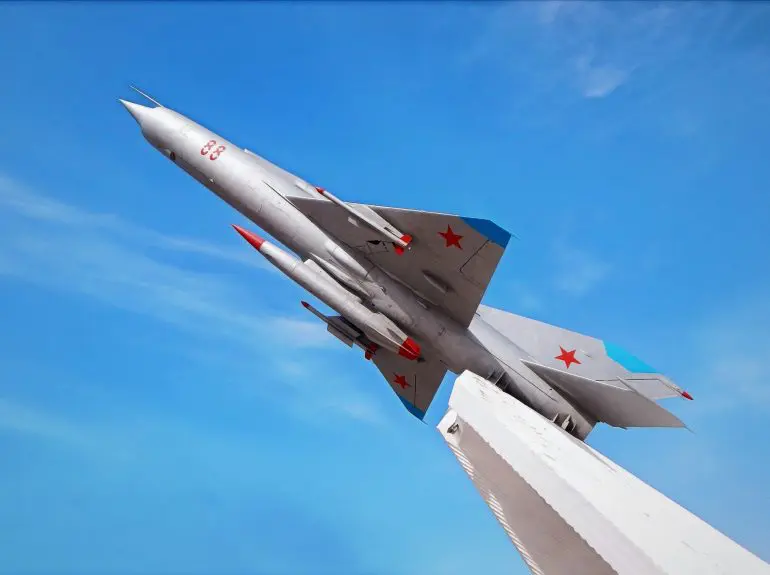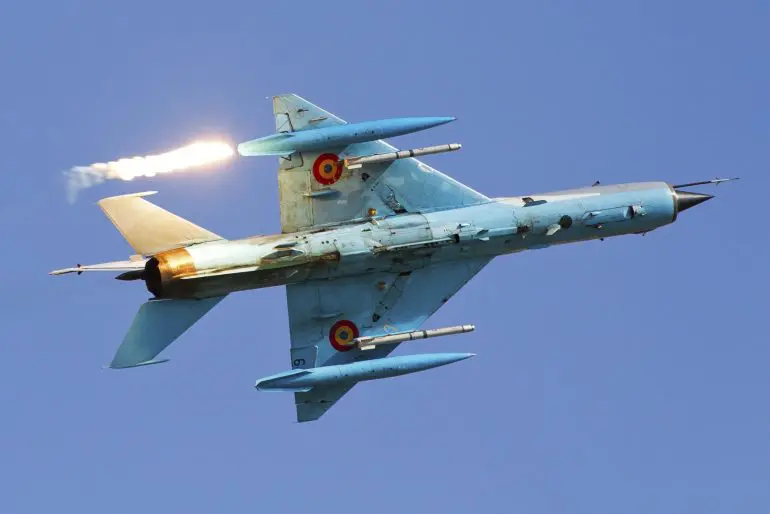NATO called it Fishbed. The Soviets nicknamed it balalaika, because its wings resembled the Russian stringed musical instrument. The Polish named it after their word for pencil – ołówek – due to the shape of the fuselage, and the Vietnamese called it Én Bạc, or ‘silver swallow.’ However it was known, the MiG-21 jet was a supersonic sensation. With its distinctive delta wing design and astonishing speed, it became a symbol of Soviet engineering prowess during the Cold War and beyond.
America’s National Air & Space Museum dubbed the MiG-21 ‘Russia’s first truly modern second-generation jet fighter’. Its simplicity, reliability, and performance made it a pilot’s favourite and a formidable adversary. In fact it was so good, dozens of upgraded variants of the MiG 21 fighter are still in use in air forces around the world.
Read on to find out why the Soviet MiG-21, a battle-hardened street fighter, is considered to be one of the most capable planes in the pantheon of air-to-air combat.
The History of the MiG-21 Fighter

Soviet MiG-21 on a pedestal, Aktau, Kazakhstan (Credit: ekipaj via Getty Images)
The development of the MiG-21 was driven by the Soviet Union’s need for a lightweight and very fast interceptor-fighter that could be built quickly, cheaply and in big numbers. They needed a plane to take on the best the Europeans and Americans had to offer. What they ended up with was a revelation.
Designed and developed by the Mikoyan-Gurevich Design Bureau, founded in 1939 by Artem Mikoyan and Mikhail Gurevich, the MiG-21 (the middle ‘i’ is Russian for ‘and’) was a continuation of the subsonic MiG-15 and MiG-17, and the Mach 1-capable MiG-19.
The MiG-21 project began in the early 1950s. The goal was to create a versatile platform capable of performing multiple roles in aerial combat. The MiG 21 airplane was intended to intercept and destroy enemy aircraft, including bombers and reconnaissance planes, while also engaging in dogfights with enemy fighters. Early prototypes – named Ye-2 and Ye-4 – were tested in 1955, exploring different wing configurations and aerodynamic concepts. These prototypes led to the final design featuring a delta wing, which was vital for achieving high speeds and manoeuvrability.
By developing an aircraft that could fulfil both interception and fighter missions, the Soviets could deploy thousands of planes across their vast territories and allied nations quickly, and without the need for specialised aircraft for each mission type. This approach also streamlined training and maintenance processes.
The final prototype produced in 1956 led to the production of the Mikoyan-Gurevich MiG 21.
The Mach 2 Marvel

The legendary MiG-21 in flight (Credit: mobil11 via Getty Images)
With its lightweight airframe and a powerful turbojet engine, the MiG-21 was the first Soviet jet aircraft capable of reaching Mach 2 – or twice the speed of sound – at high altitude.
This milestone was significant for the Soviet Union, as it allowed them to match or exceed the speed capabilities of Western fighter jets of that era, including the American Lockheed F-104 Starfighter and Northrop F-5 Freedom Fighter, the French Dassault Mirage III, and the English Electric Lightning.
Production & Deployment

Cockpit of the Mikoyan-Gurevich MiG-21 (Credit: ivansmuk via Getty Images)
The Mig-21 entered service with the Soviet Air Force in 1959. Generally, new fighters were introduced to units stationed along the Soviet Union’s western borders, where they could counter NATO forces during the Cold War. These units were typically part of the Soviet Air Defence Forces or front-line tactical aviation regiments responsible for protecting Soviet airspace and supporting ground operations.
In total, just over ten and a half thousand MiG-21 fighters were built in the Soviet Union, with approximately 850 more built under licence in India and Czechoslovakia. Its introduction marked a milestone in aviation, and it remains the most produced supersonic jet-powered military aircraft in history.
The MiG-21 Jet in Combat

Romanian Air Force MiG-21 MF LanceR-C, 2012 (Credit: Anton Balakchiev/Stocktrek Images via Getty Images)
This Soviet supersonic jet played a pivotal role in numerous conflicts during the Cold War and beyond. First entering combat in the mid-1960s, the Mikoyan-Gurevich MiG 21 became a primary fighter aircraft for several nations. During the Vietnam War, it was operated by the North Vietnamese Air Force against U.S. aircraft. In the intense aerial battles over Vietnam, including Operation Rolling Thunder and later Operation Linebacker, the MiG-21 – though less advanced in comparison to American fighters like the F-4 Phantom II – proved formidable due to its agility, small size, and effective hit-and-run tactics.
It was active in the Middle East and during the Indo-Pakistan Wars in the 1960s and 1970s, and while official statistics on kill ratios involving the MiG-21 are often disputed, it’s clear that the aircraft achieved considerable success. Regardless of the exact figures, the impact of the MiG-21 fighter on air combat tactics and its ability to challenge more technologically advanced adversaries is legendary.
The MiG-21 would ultimately serve with over fifty air forces across the globe, including those of Afghanistan, Angola, Cuba, Egypt, Ethiopia, Finland, and Poland and was involved in various regional conflicts and border skirmishes.
While its combat role diminished with the introduction of more advanced aircraft, the MiG-21 remained in service due to its reliability and ease of maintenance. Some nations continued to upgrade their fleets with modern avionics and weaponry well into the twenty-first century. As of the early 2020s, it remains in limited operational use by a number of air forces around the world.
Specification

A Bulgarian Air Force MiG-21bis (Credit: Anton Balakchiev/Stocktrek Images via Getty Images)
There were dozens of different variants of the MiG-21 jet, but the figures listed below are the specifications of the MiG-21bis which entered production in 1972.
- Length | 14.7 metres (excluding the pitot boom)
- Wingspan | 7.2 metres
- Height | 4.1 metres
- Wing Area | 23 m2
- Engine | 1 x Tumansky R-25-300 afterburning turbojet
- Crew | 1
- Maximum Speed | 1,351 mph (2,175 km/h) @ 13,000 metres/43,000 ft
- Maximum Range | Up to 1,220 km (760 miles) with internal fuel tanks and 1,470 km (913 miles) with external fuel tanks
- Service Ceiling | 17,500 metres (57,400 ft)
The armaments for the MiG-21bis varied depending on the specific configuration, but one example of the armament set-up would be –
- 1 x internal 23mm Gryazev-Shipunov GSh-23L autocannon with 200 rounds
- 5 x external attachments, known as hardpoints, carrying 4 x S-24 or 4 x U-16-57 rockets, as well as Vympel K-13, Kaliningrad K-5, or Molniya R-60 air-to-air missiles
- 2 x 1,100 lb and 2 x 550 lb bombs
The Legacy of the MiG-21

Retired Russian Air Force MiG-21 jets (Credit: Photofex-AT via Getty Images)
While the American Phantoms and the French Dassaults were elite heavyweights, the MiG-21 was a tough street brawler, but what the Soviet plane lacked in finesse, it more than made up for it where it counted – in combat in the sky.
Basic and rugged with few creature comforts, and with the ability to operate anywhere from paved runways to potholed paths, the Mikoyan-Gurevich MiG 21 proved that sometimes simplicity and reliability can outmatch complexity and sophistication.
The MiG-21 jet not only pushed the limits of speed and performance, but also set a benchmark for fighter design that balanced cost with capability.










